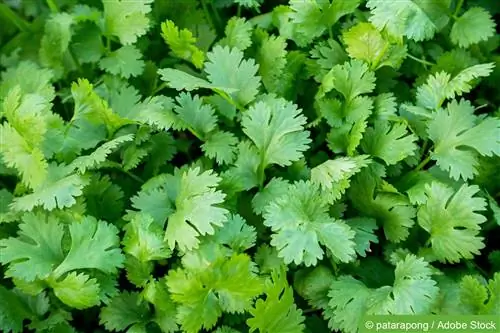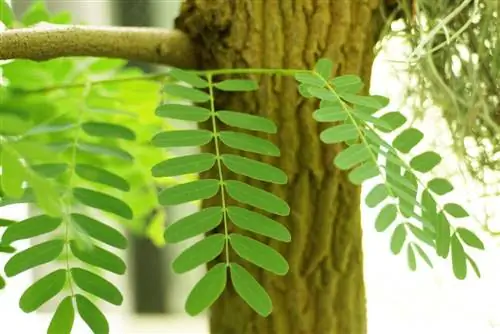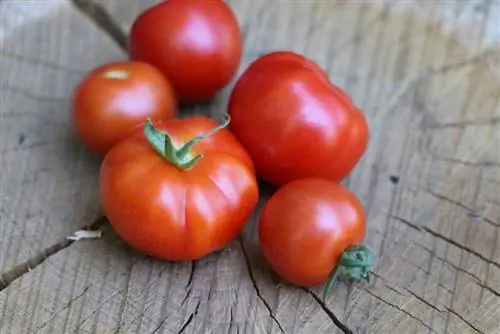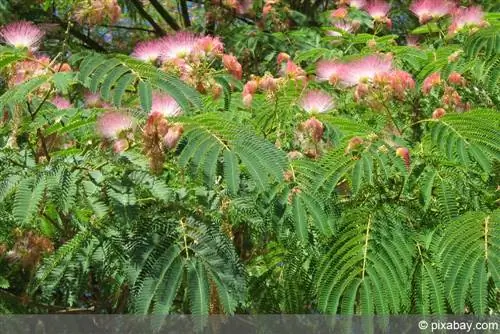- Author admin [email protected].
- Public 2023-12-17 03:39.
- Last modified 2025-01-24 12:45.
The Coriandrum sativum - also called real coriander - is popular in the kitchens of various cultures and is often used to refine the taste. The plant not only offers tasty leaves, but also powerful seeds that are particularly used in East Asian and oriental cuisine. Caring for the plant is relatively undemanding and only requires a certain amount of prior knowledge about the location and fertilization methods. If all tips are followed during the germination and young plant phase, the harvest will be productive and worthwhile.
Substrate and soil
Sowing the seeds of the coriander plant does not require any specific requirements. A soil containing clay or sand is also sufficient for sowing seeds. Since the plant is relatively undemanding, it is possible to use the same nutrient medium multiple times over several years in a row, which saves the hobby gardener work and money.
Sowing
Since real coriander can tolerate light frost, the seeds can be sown quite early. For an optimal harvest, we recommend sowing between mid and late March - at the latest at the beginning of April. Coriandrum sativum is a dark germinator, which means the seeds should be sown at a depth of 1-2 cm. The seeds should be arranged in rows, each about 20-25 cm apart.
Care during the germination phase
In order for the coriander germs to sprout ideally, the temperature of the location during the germination phase should be between 5 °C and 25 °C. The germination phase lasts just under two to three weeks. The sprouts should then mostly penetrate the soil. During the germination phase, the seeds need the highest amount of water. Care should be taken to ensure a regular, plentiful supply of water without causing waterlogging.
Location
The location for the coriander should provide the ideal moisture. Even though the plant is a rather undemanding project, drought should be avoided at all costs. This can quickly lead to drought stress, which then causes the shoots to stretch prematurely. That's why a sunny to semi-shady location is recommended for real coriander. Ideally, the sun shines at this location in the morning hours. In the afternoon it should be rather shady.
In the greenhouse
Gardening in greenhouses is becoming increasingly attractive for many hobby gardeners. In the greenhouse, Coriandrum sativum can be sown earlier and therefore harvested earlier. Here you can also consider whether you would prefer to plant the seeds in a pot culture instead of directly in the growing medium. A press culture is recommended for an early harvest, although this requires a certain level of skill and sophistication. If sowing in a greenhouse, a sun protector should be used if necessary. In any case, care should be taken to ensure sufficient water supply even when sowing seeds in a greenhouse.
General Care
As already mentioned many times, Coriandrum sativum is an extremely easy-care plant. However, some care tips should be followed in order to achieve a successful harvest in late summer. A high frequency of watering should be maintained, especially in the young stage of the plant. Later, when the plant has grown beyond the essential germination and sprouting phase, water should continue to be supplied regularly, but less water overall. Coriander is very weak in competition with weeds, so any weeds should be removed immediately if possible.
Tip:
To minimize the annoying weeding, a thin layer of mulch between the young plants helps.
If weak seedlings are discovered, they should also be removed as quickly as possible, otherwise they will deprive the other sprouts of important nutrients. In general, the following fertilizer tips should also be observed.
Fertilize
A very popular and effective fertilizer for promoting growth and plant quality is compost. Distribute this in thin layers along the rows of seeds, ensuring an even thickness. Liquid fertilizer is also very effective - but it should be enjoyed in moderation. Before sowing, some measures can be taken that will significantly improve the growth of the plant. It is best to dig up the soil before sowing and add a 5 to 8 cm thick layer of manure or mulch. Algae lime in the soil strengthens the fungal and insect defense and promotes the breeding ground.
Harvest
The coriander leaves and seeds are usually harvested approx. 24 weeks after sowing, i.e. in late summer between the end of July and the beginning of August. Ideally, harvesting is done from top to bottom, so the top leaves should be picked first. If this advice is not followed, flowering will most likely occur again, which will prevent the development of new shoots. The seeds are usually harvested shortly before they are fully ripe. The best time to harvest seeds is early morning. The harvested seeds should dry on paper for the rest of the day. Over the course of this day, the seeds will release themselves and can finish ripening in a dry cotton bag.
Coriander seeds
If you want to specifically harvest coriander seeds, start growing the plants indoors in April. If you want to plant the seedlings outdoors, choose a location that is quite sunny, sheltered from the wind and warm. For this purpose, the distance between the individual plants should be approximately 20 cm.
Apart from occasional hoeing to remove weeds and loosen the soil, the coriander plants make no further demands. The herb with the richly branched shoots will grow to a height of around 70 to 90 cm and will produce single, white to delicate pink flower umbels in mid-summer. The seeds of coriander then develop from these flowers. They have plenty of essential oil. When the seeds turn brown, it is time to harvest. You shouldn't be hesitant here either, otherwise the seeds will fall out.
The harvest time is usually in August to September:
- You cut off the seed heads,
- then hang it up to dry or
- The seeds are allowed to mature in a dry place in an airy cotton bag.
Diseases
One of the most common diseases of the coriander plant is umbel cloud or umbel blight. This is caused by a fungus that causes the leaves to wilt severely and ultimately kills the plant. Maintaining humidity that is not too high is particularly important when preventing umbel clouds, as this greatly promotes the formation of the fungus. Since there is currently no known antidote to the fungus, all affected plants should be removed immediately and completely. In the following year, new soil should under all circumstances be created to prevent the fungus from forming again. Of course, powdery mildew is also a serious threat to the plant. It is also important to ensure that the growing medium is moderately moist. In the best case scenario, you should not water in the evening, otherwise the soil will remain very moist overnight and promote mildew. If powdery mildew still occurs, you can use
- Baking powder
- dishwashing liquid
- Cooking oil
- Water
Make an effective anti-mildew spray.
Frequently asked questions
Can you still eat coriander if it is affected by mildew?
Yes, but the mildew should be rinsed off thoroughly with water before consumption.
How to make liquid fertilizer for the plant at home?
Mix starchy water, coffee grounds, egg and onion peels, dandelions and stinging nettles and wait two weeks. Coriander (Coriandrum sativum) comes from the Orient, which is why the very old cultivated plant is sometimes called “Indian parsley”. Together with caraway and fenugreek, coriander from the Indian subcontinent also came to our local herb beds.
What you should know about coriander in brief
Plants
- If you want to use the fresh leaves of the coriander and place less value on the seeds of the spice plant, it is best to grow them yourself from seeds or plant young plants from a well-stocked nursery.
- The seeds can be sown from mid-May, after the ground has warmed up. A plant spacing of around 5 cm can already be taken into account. You can also separate the young plants later.
- After about 3 weeks, the coriander planted outdoors will germinate. Since each contains 2 seeds, 2 seedlings can grow from one grain. The smaller and weaker seedling should be removed.
- Coriander plants can be grown even earlier in the shelter of the house or sown in flower pots. Then the germination time is shortened to 2 weeks.
You should not wait too long before transplanting into open garden land. The young coriander plant may react sensitively because of the roots that develop quickly and quite long. If you want to grow coriander in a flower pot, you should mix the herb soil with a little sand beforehand. Later, the herb pots are best placed on the balcony or terrace because coriander smells strong and bitter.
- The young plants should not become dry. Very sunny locations may need to be additionally shaded.
- If the plants are larger, they can tolerate drier phases.
- Waterlogging is poison for them - regardless of whether they are grown outdoors or in flower pots.
Usage
- Both the herb and the seeds of coriander can be used to cleverly season soups, meat and fish dishes, salads, cabbage and sauerkraut.
- In addition, coriander is a classic ingredient in gingerbread and bread spices as well as Indian curry mixtures.
- Fresh leaves have a citrus-like aroma and traditionally enrich not only Indian dishes but also classic Arabic, Mexican and Chinese cuisine.
- Coriander seeds have soothing and healing effects against bloating and flatulence. When mixed with cardamom and caraway you get a soothing digestive tea.
- The decorative value of the beautiful coriander flower umbels in the garden bed as well as in the bouquet should not go unmentioned. However, not everyone loves the bitter smell of coriander.






